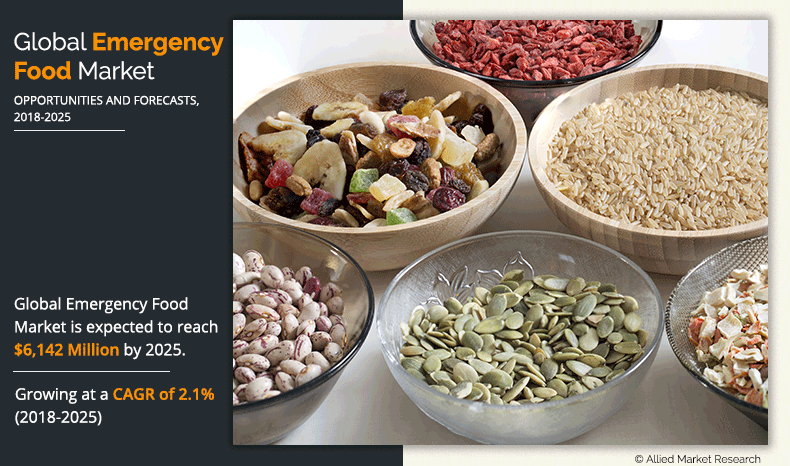According to a new report published by Allied Market Research titled,“Emergency Food Market by Product Type and region:Global Opportunity Analysis and Industry Forecast, 2018-2025,“the global emergency food market size was valued at $5,169 million in 2017, and is projected to reach $6,142 million by 2025, growing at a CAGR of 2.1% from 2018 to 2025. In 2017, the North America sector accounted for nearly 45.0 % of the emergency food market share.
The global emergency food market is segmented into product type and region. Based on product type, the market is divided into ready to eat meals, protein or fruit bar, dry cereal or granola, peanut butter, dried fruit, canned juice, non-perishable pasteurized milk and infant food.
Download Sample Report: https://www.alliedmarketresearch.com/request-sample/5235
Over the past four decades, the consumption rate of food products that requires minimal time for preparation has been on the rise especially in economically developed countries. Government of economically developing or under developed regions have been taking active steps on providing basic necessities to the part of population thriving in regions enduring various uncertain climatic conditions. This has resulted in demand for various emergency food products from the governments end which could cater to the rising needs and requirements of the people living in such regions. Several macro-economic factors have influenced the market of such emergency food products such increase in workforce participation rate, decline in prices for various convenience food products, and rise in per capita income of consumers, especially in North America, Europe, and Asia-Pacific which has eventually driven the emergency food industry by values sales.
Emergency food products play a crucial role in the defense sector. Army personnel are posted in war zones, where there is low access to food and water. In such situations, army personnel are forced to carry food and beverages on emergency basis. Thus, emergency food products such as dried fruits and ready-to-eat meals cater to their requirements. As a result, army sector is considered as the prime customer of the emergency food market forecast.
Get detailed COVID-19 impact analysis on the Emergency Food Market @ https://www.alliedmarketresearch.com/request-for-customization/5235?reqfor=covid
The emergency food product provides a wide range of product portfolio which caters to the varying needs and requirements of target customers. However, the penetrations of such products are low especially in economically undeveloped countries. In African nations, region experience uncertain climatic conditions due to which there is higher need for emergency food product. However, the distribution channel in these regions are low.
According to the World Health Organization (WHO), there are approximately 10 million nongovernmental organizations (NGO) around the world. Helping, supporting, and providing basic amenities (food and clothing) to the poor and needy is one of their key roles. Some of the major NGOs have strategized on merging with emergency food suppliers to cater to the needs of these people. Availability of preprocessed food is anticipated to reduce cooking time and provide better & quick service to these consumers. Thus, collaboration with NGOs is anticipated to boost the demand for ready meals, thereby supplementing the emergency food market growth.
Get Discount up to 25% for Purchase Enquiry Copy on Report (Validity on 25th April 2022 to 10th May 2022): https://www.alliedmarketresearch.com/purchase-enquiry/5235
Key Findings of The Emergency Food Market:
In 2017, based on product type, the non-perishable pasteurized milk segment accounted for around 20.0 % of the emergency food market share, growing at a CAGR of 1.7% from 2018 to 2025.
Over the forecast period, peanut butter segment is expected to gain faster traction, growing at a CAGR of 2.8% between 2018 to 2025.
In 2017, North America accounted for 45.0% of the emergency food market share growing at CAGR of 1.8% from 2018 to 2025.
In North America, Canada is expected to witness higher growth rate in terms of value sales over the forecast period.
Asia Pacific region is expected to witness significant growth in the emergency food market over the forecast period growing at a CAGR of 3.6% from 2018 to 2025.
The key players profiled in this report include the key companies profiled in the report include Nestle S.A., Kraft Foods Group Inc., General Mills Inc., Kellogs, Conagra Brands Inc., PepsiCo, The Coca-Cola Company, Del Monte Foods Inc., CHB, and Princes Limited.
Similar Reports:
Global Free from Food Market Expected to Reach $161.2 Billion by 2026
Global Lactose Free Butter Market Expected to Reach $388.4 Million by 2026
About Allied Market Research:
Allied Market Research (AMR) is a full-service market research and business-consulting wing of Allied Analytics LLP based in Portland, Oregon. Allied Market Research provides global enterprises as well as medium and small businesses with unmatched quality of “Market Research Reports” and “Business Intelligence Solutions.” AMR has a targeted view to provide business insights and consulting to assist its clients to make strategic business decisions and achieve sustainable growth in their respective market domains. AMR offers its services across 11 industry verticals including Life Sciences, Consumer Goods, Materials & Chemicals, Construction & Manufacturing, Food & Beverages, Energy & Power, Semiconductor & Electronics, Automotive & Transportation, ICT & Media, Aerospace & Defense, and BFSI.
We are in professional corporate relations with various companies and this helps us in digging out market data that helps us generate accurate research data tables and confirms utmost accuracy in our market forecasting. Each and every data presented in the reports published by us is extracted through primary interviews with top officials from leading companies of domain concerned. Our secondary data procurement methodology includes deep online and offline research and discussion with knowledgeable professionals and analysts in the industry.
